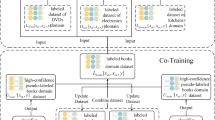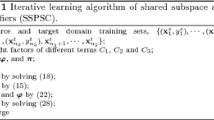Abstract
Social emotion classification is important for better capturing the preferences and perspectives of individual users to monitor public opinion and edit news. However, news reports have a strong domain dependence. Moreover, training data in the target domain are usually insufficient and only a small amount of training data may be labeled. To address these problems, we develop a cluster-level method for social emotion classification across domains. By discovering both source and target clusters and weighting the cluster in the source domain according to the similarity between its distribution and that of the target cluster, we can discover common patterns between the source and target domains, thus using both source and target data more effectively. Extensive experiments involving 12 cross-domain tasks conducted by using the ChinaNews dataset show that our model outperforms existing methods.


Similar content being viewed by others
Notes
For instance, a news report may have the following distribution of votes from readers over 6 emotions: {0.5, 0.3, 0.2, 0, 0, 0}, where 0.5 means that the news article gets 50% reader votes over the first emotion category.
References
Akhtar MS, Ekbal A, Cambria E (2020) How intense are you? Predicting intensities of emotions and sentiments using stacked ensemble [application notes]. IEEE Comput Intell Mag 15(1):64–75
Alsaedi A, Brooker P, Grasso F, Thomason S (2021) A survey of social emotion prediction methods. In: Proceedings of the 10th international conference on data science, technology and applications, pp 223–230
Alsaedi A, Brooker P, Grasso F, Thomason S (2022) Improving social emotion prediction with reader comments integration. In: Proceedings of the 14th international conference on agents and artificial intelligence, pp 285–292
Bao S, Xu S, Zhang L, Yan R, Su Z, Han D, Yu Y (2012) Mining social emotions from affective text. IEEE Trans Knowl Data Eng 24(9):1658–1670
Blitzer J, Dredze M, Pereira F (2007) Biographies, Bollywood, boom-boxes and blenders: domain adaptation for sentiment classification. In: Proceedings of the 45th annual meeting of the association of computational linguistics, pp 440–447
Blitzer J, McDonald R, Pereira F (2006) Domain adaptation with structural correspondence learning. In: Proceedings of the 2006 conference on empirical methods in natural language processing, pp 120–128
Bravo-Marquez F, Mendoza M, Poblete B (2014) Meta-level sentiment models for big social data analysis. Knowl Based Syst 69:86–99
Cambria E (2016) Affective computing and sentiment analysis. IEEE Intell Syst 31(2):102–107
Canales L, Daelemans W, Boldrini E, Martínez-Barco P (2022) EmoLabel: semi-automatic methodology for emotion annotation of social media text. IEEE Trans Affect Comput 13(2):579–591
Chambers N, Bowen V, Genco E, Tian X, Young E, Harihara G, Yang E (2015) Identifying political sentiment between nation states with social media. In: Proceedings of the 2015 conference on empirical methods in natural language processing, pp 65–75
Dai L, Wang B, Xiang W, Xu M, Xu H (2022) A hybrid semantic-topic co-encoding network for social emotion classification. In: Proceedings of the 26th Pacific-Asia conference on advances in knowledge discovery and data mining, pp 587–598
Ding K, Li J, Zhang Y (2020) Hashtags, emotions, and comments: A large-scale dataset to understand fine-grained social emotions to online topics. In: Proceedings of the 2020 conference on empirical methods in natural language processing, pp 1376–1382
Dragoni M, Donadello I, Cambria E (2021) OntoSenticNet 2: enhancing reasoning within sentiment analysis. IEEE Intell Syst 36:5
Feng J, Rao Y, Xie H, Wang FL, Li Q (2020) User group based emotion detection and topic discovery over short text. World Wide Web Internet Web Inf Syst 23:1553–1587
Griffiths TL, Steyvers M, Blei DM, Tenenbaum JB (2005) Integrating topics and syntax. In: Proceedings of the advances in neural information processing systems, pp 537–544
Hemmatian F, Sohrabi MK (2019) A survey on classification techniques for opinion mining and sentiment analysis. Artif Intell Rev 52:1495–1545
Hu M, Liu B (2004) Mining and summarizing customer reviews. In: Proceedings of the 10th ACM SIGKDD international conference on knowledge discovery and data mining, pp 168–177
Huang M, Xie H, Rao Y, Feng J, Wang FL (2020) Sentiment strength detection with a context-dependent lexicon-based convolutional neural network. Inf Sci 520:389–399
Huang M, Xie H, Rao Y, Liu Y, Poon LKM, Wang FL (2022) Lexicon-based sentiment convolutional neural networks for online review analysis. IEEE Trans Affect Comput 13(3):1337–1348
Hussain A, Cambria E, Poria S, Hawalah AY, Herrera F (2021) Information fusion for affective computing and sentiment analysis. Inf Fusion 71:97–98
III HD, Marcu D (2011) Domain adaptation for statistical classifiers. CoRR abs/1109.6341
Katz G, Ofek N, Shapira B (2015) ConSent: context-based sentiment analysis. Knowl Based Syst 84:162–178
Li L, Jin X, Long M (2012) Topic correlation analysis for cross-domain text classification. In: Proceedings of the 26th AAAI conference on artificial intelligence, pp 998–1004
Li X, Peng Q, Sun Z, Chai L, Wang Y (2019) Predicting social emotions from readers’ perspective. IEEE Trans Affect Comput 10(2):255–264
Li X, Rao Y, Chen Y, Liu X, Huang H (2016) Social emotion classification via reader perspective weighted model. In: Proceedings of the 30th AAAI conference on artificial intelligence, pp 4230–4231
Li X, Xie H, Song Y, Zhu S, Li Q, Wang FL (2015) Does summarization help stock prediction? A news impact analysis. IEEE Intell Syst 30(3):26–34
Li Z, Chen X, Xie H, Li Q, Tao X, Cheng G (2021) EmoChannel-SA: exploring emotional dependency towards classification task with self-attention mechanism. World Wide Web Internet Web Inf Syst 24:2049–2070
Li Z, Xie H, Cheng G, Li Q (2021) Word-level emotion distribution with two schemas for short text emotion classification. Knowl Based Syst 227:107163
Mishra A, Dey K, Bhattacharyya P (2017) Learning cognitive features from gaze data for sentiment and sarcasm classification using convolutional neural network. In: Proceedings of the 55th annual meeting of the association for computational linguistics, pp 377–387
Mou X, Peng Q, Sun Z, Wang Y, Li X, Bashir MF (2021) A deep learning framework for news readers’ emotion prediction based on features from news article and pseudo comments. IEEE Trans Cybern. https://doi.org/10.1109/TCYB.2021.3112578
Nakagawa T, Kitada S, Iyatomi H (2022) Expressions causing differences in emotion recognition in social networking service documents. In: Proceedings of the 31st ACM international conference on information & knowledge management, pp 4349–4353
Pan SJ, Ni X, Sun JT, Yang Q, Chen Z (2010) Cross-domain sentiment classification via spectral feature alignment. In: Proceedings of the 19th international conference on World Wide Web, pp 751–760
Pang B, Lee L (2005) Seeing stars: exploiting class relationships for sentiment categorization with respect to rating scales. In: Proceedings of the 43rd annual meeting of the association for computational linguistics, pp 115–124
Pang B, Lee L, Vaithyanathan S (2002) Thumbs up? Sentiment classification using machine learning techniques. In: Proceedings of the 2002 conference on empirical methods in natural language processing, pp 79–86
Pang J, Rao Y, Xie H, Wang X, Wang FL, Wong TL, Li Q (2021) Fast supervised topic models for short text emotion detection. IEEE Trans Cybern 51(2):815–828
Qin X, Chen Y, Rao Y, Xie H, Wong ML, Wang FL (2021) A constrained optimization approach for cross-domain emotion distribution learning. Knowl Based Syst 227:107160
Rao Y (2016) Contextual sentiment topic model for adaptive social emotion classification. IEEE Intell Syst 31(1):41–47
Rao Y, Li Q, Wenyin L, Wu Q, Quan X (2014) Affective topic model for social emotion detection. Neural Netw 58:29–37
Ravi K, Ravi V (2015) A survey on opinion mining and sentiment analysis: tasks, approaches and applications. Knowl Based Syst 89:14–46
dos Santos C, Gatti M (2014) Deep convolutional neural networks for sentiment analysis of short texts. In: Proceedings of the 25th international conference on computational linguistics, pp 69–78
Strapparava C, Mihalcea R (2007) SemEval-2007 task 14: affective text. In: Proceedings of the 4th international workshop on semantic evaluations, pp 70–74
Wang C, Wang B (2020) An end-to-end topic-enhanced self-attention network for social emotion classification. In: Proceedings of the web conference, pp 2210–2219
Wang C, Wang B, Xiang W, Xu M (2019) Encoding syntactic dependency and topical information for social emotion classification. In: Proceedings of the 42nd international conference on research & development in information retrieval, pp 881–884
Weichselbraun A, Gindl S, Scharl A (2014) Enriching semantic knowledge bases for opinion mining in big data applications. Knowl Based Syst 69:78–85
Xia R, Zong C, Hu X, Cambria E (2015) Feature ensemble plus sample selection: domain adaptation for sentiment classification. In: Proceedings of the 24th international conference on artificial intelligence, pp 4229–4233
Yang Y, Zhou D, He Y (2018) An interpretable neural network with topical information for relevant emotion ranking. In: Proceedings of the 2018 conference on empirical methods in natural language processing, pp 3423–3432
Yang Y, Zhou D, He Y, Zhang M (2019) Interpretable relevant emotion ranking with event-driven attention. In: Proceedings of the 2019 conference on empirical methods in natural language processing and the 9th international joint conference on natural language processing, pp 177–187
Zhang Y, Fu J, She D, Zhang Y, Wang S, Yang J (2018) Text emotion distribution learning via multi-task convolutional neural network. In: Proceedings of the 27th international joint conference on artificial intelligence, pp 4595–4601
Zhang Y, Zhang N, Si L, Lu Y, Wang Q, Yuan X (2014) Cross-domain and cross-category emotion tagging for comments of online news. In: Proceedings of the 37th international ACM SIGIR conference on research & development in information retrieval, pp 627–636
Zhao Z, Ma X (2019) Text emotion distribution learning from small sample: a meta-learning approach. In: Proceedings of the 2019 conference on empirical methods in natural language processing and the 9th international joint conference on natural language processing, pp 3955–3965
Zhou D, Wang J, Zhang L, He Y (2021) Implicit sentiment analysis with event-centered text representation. In: Proceedings of the 2021 conference on empirical methods in natural language processing, pp 6884–6893
Zhou Y, Liao L, Gao Y, Wang R, Huang H (2021) TopicBERT: a topic-enhanced neural language model fine-tuned for sentiment classification. IEEE Trans Neural Netw Learn Syst. https://doi.org/10.1109/TNNLS.2021.3094987
Zhu E, Rao Y, Xie H, Liu Y, Yin J, Wang FL (2017) Cluster-level emotion pattern matching for cross-domain social emotion classification. In: Proceedings of the 2017 ACM conference on information and knowledge management, pp 2435–2438
Zhuang F, Luo P, Xiong H, He Q, Xiong Y, Shi Z (2010) Exploiting associations between word clusters and document classes for cross-domain text categorization. In: Proceedings of the SIAM international conference on data mining, pp 13–24
Funding
The research described in this article has been supported by a grant from the Research Grants Council of the Hong Kong Special Administrative Region, China under Grant UGC/FDS16/E01/19; Lam Woo Research Fund (LWP20019), and the Faculty Research Grants (DB22B4 and DB23A3) of Lingnan University, Hong Kong.
Author information
Authors and Affiliations
Corresponding author
Ethics declarations
Conflict of interest
The authors declare that they have no conflicts of interest.
Informed consent
Informed consent was not required as no humans or animals were involved.
Human and animal rights
This article does not present any studies with human or animal subjects performed by any of the authors.
Additional information
Publisher's Note
Springer Nature remains neutral with regard to jurisdictional claims in published maps and institutional affiliations.
Rights and permissions
Springer Nature or its licensor (e.g. a society or other partner) holds exclusive rights to this article under a publishing agreement with the author(s) or other rightsholder(s); author self-archiving of the accepted manuscript version of this article is solely governed by the terms of such publishing agreement and applicable law.
About this article
Cite this article
Wang, F.L., Zhao, Z., Cheng, G. et al. Weighted cluster-level social emotion classification across domains. Int. J. Mach. Learn. & Cyber. 14, 2385–2394 (2023). https://doi.org/10.1007/s13042-022-01769-3
Received:
Accepted:
Published:
Issue Date:
DOI: https://doi.org/10.1007/s13042-022-01769-3




